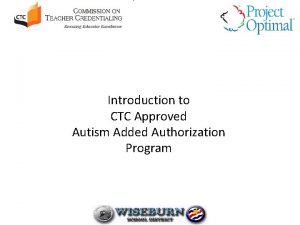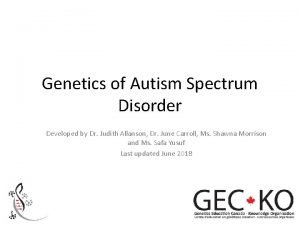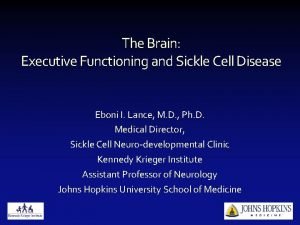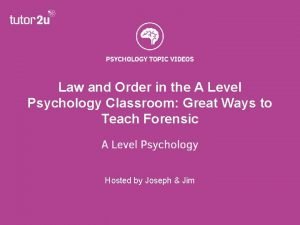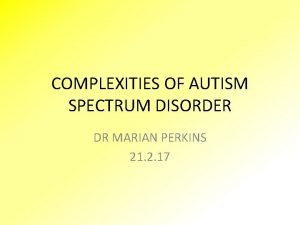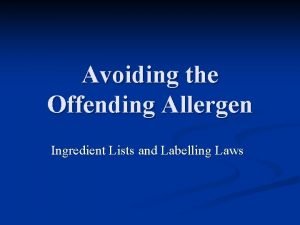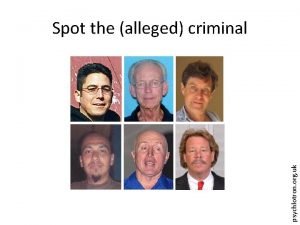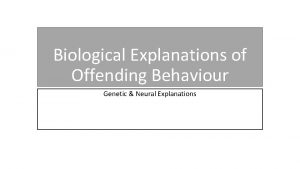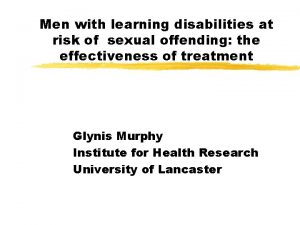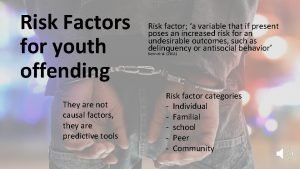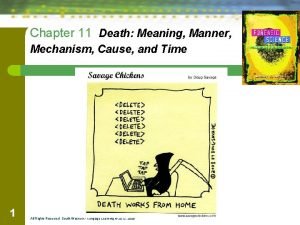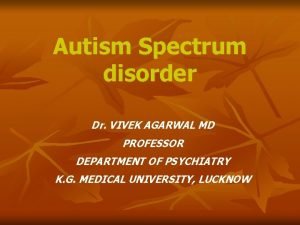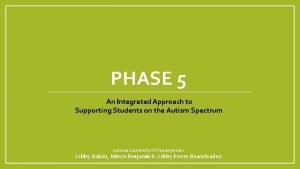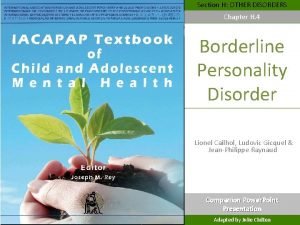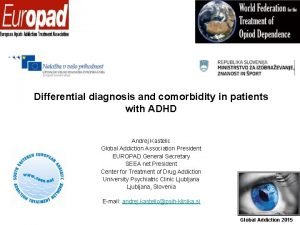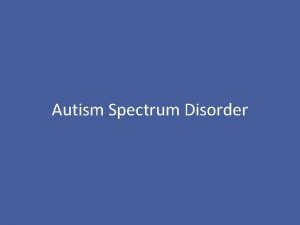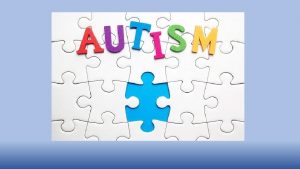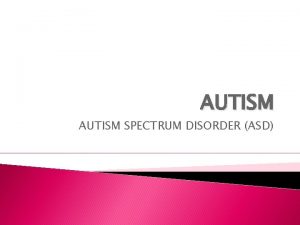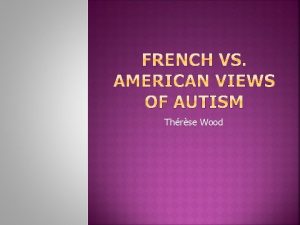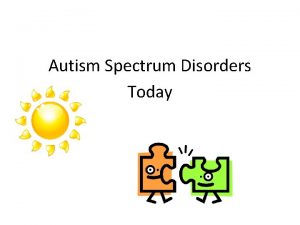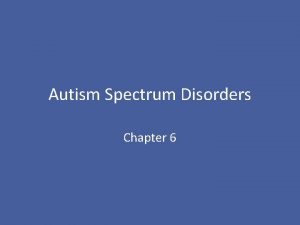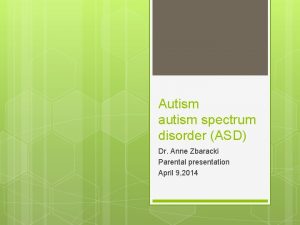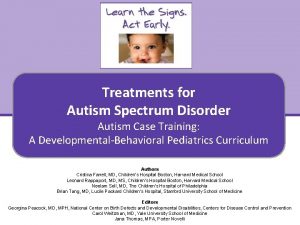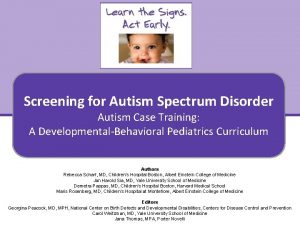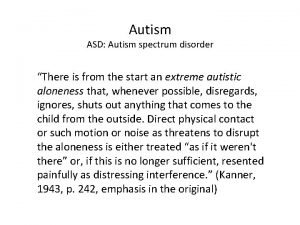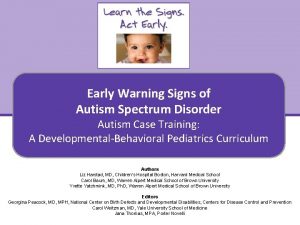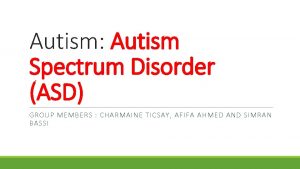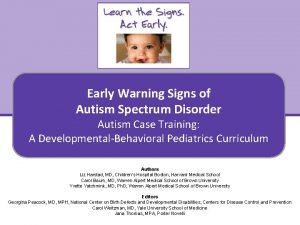Autism Spectrum Disorder Personality Disorder and Offending Paul






















- Slides: 22

Autism Spectrum Disorder, Personality Disorder and Offending Paul Brown, Advanced Nurse Practitioner.

Background 12 bed locked ward for adult (over age of 18 years) men with Autistim Spectrum Conditions (ASD) who may present with other mental health disorders. Present with challenging and complex need. Service Users may be subject to detention under the Mental Health Act 1983 but there may also be informal patients. Provide diagnositic assessment, including ASD assessment, risk assessment and formulation.

Background 22 Service users admitted since opening: • 17 history of violence • 2 non-contact sexual offending • 1 fire-setting • 1 collecting weapons • 1 threats to kill • 10 cases led to involvement with the CJS including prison (x 2) and secure services (x 6)

Background 9 had ? ASD on admission 4 were confirmed to have an ASD 1 was confirmed not to have an ASD 4 were inconclusive Of these 5 were ? Personality Disorder And 3 were ? Schizophrenia In 2 cases both PD and S In 2 cases other disorder

Background • Differential diagnosis In addition to certain disorders co-occurring with ASD, a number of other disorders are easily mistaken for ASD in adults: Eg. Anxiety disorders – may impact on social functioning OCD – rigid, repetitive, compulsions (in ASD tend not to be tied to specific obsessive though and circumscribed interests are not tied to anxiety as are obsessive thoughts) Depression – contribute to social difficulties that can be misidentified as an ASD. Schizophrenia – lack of personal and social insight, atypical language, negative symptoms. Personality disorder – avoidant (reduce social interaction), schizoid (detachment from personal relationships), schizotypal (difficult to differentiate from ASD).

Background Challenges to Diagnosis: Symptoms affecting performance on tests (ADOS) ADOS not sensitive to positive and negative symptoms Lack of reliable historical information – school, GP, previous assessments Accumulating diagnoses over time – sometimes difficult to determine where these came from Differences in opinion Lack of clear guidance

Background • Risk Management – Clear understanding of factors that mediate or mitigate the risk behaviour – Interventions to reduce risk – Risk formulation – Role of CJS – other agencies, supervision – Treatment needs

Systematic Review of the Literature: Research Questions Q 1. What is understood about the relationship between autism spectrum disorders and offending? Q 2. What is the relationship between Theory of Mind and offending? Q 3. What is the relationship between obsessional/ restricted interests and offending? Q 4: How do practitioners assess and diagnose people with autism spectrum disorders , and how well do they distinguish them from personality disorders and psychopathy?

Systematic Review of the Literature: Method Developed a review protocol Inclusion criteria: peer review journal/English language/ aged 18+ Exclusion criteria: risk to participant/ violence or offending reported as an outcome of an intervention/medication or treatment trials/generic LD studies/victim perspective/single case studies/unpublished work/dissertations

Systematic Review of the Literature: Search Strategy Search of electronic databases: CINHAL, Embase, Medline, Psyc. INFO Search terms agreed by both researches and enhanced using Athens thesaurus Included terms associated with ASD, offending, risk, To. M, restricted interests, PD, risk assessment, co-morbidity, diagnosis

Systematic Review of the Literature: Search Strategy A total of 25 papers were included: Q 1: eight papers Q 2: eight papers Q 3: five papers Q 4: eight papers (>25 as some papers met criteria for more than one paper).

Q 1: What is understood about the relationship between autism spectrum disorders and offending? • Eight papers included • Designs varied in terms of popn. sampled and offense outcome measures. Sample sizes. Issues around reliability of ASD diagnosis. • For example: Use of historical diagnosis not validated by authors Only one report sought to validate using ADI-R

Q 1: What is understood about the relationship between autism spectrum disorders and offending? • Offenses varied from minor offenses – criminal damage, theft – to more serious offenses – sexual offending, homicide, violence, arson. • No definite pattern of offense types established • Similar rates of convictions compared to controls • Male arsonists vs male violent offenders more likely to have a diagnosis of Asperger’s syndrome (7. 1% vs. 2. 5%; p<. 01) • Compared to controls the Asperger cases sig higher rates of convictions for arson (p=. 0009)

Q 1: What is understood about the relationship between autism spectrum disorders and offending? • AS participants entered hospital 4/5 years younger than those with MI (p<0. 05) but similar to PD participants (Murphy 2003) • Individuals with AS who committed violent offences were more likely to be older and male (Murphy 2003) • AS patients likely to have less severe index offence violence ratings compared to MI or PD group (Murphy, 2003) • Diagnosis of ASD associated with physical aggression (object, self, other) as opposed to verbal aggression. • ASD violent offenders had high levels of co-morbid psychopathology compared with nonviolent offender: psychosis, PD, substance abuse (Langstrom et al. 2008) • Allen et al. (2008) highlighted prevalence of comorbid psychopathology in study on AS who offend. • Participants less likely involved in drug related activities compared to controls (12%v 55%) (Mouridson et al. 2008).

Q 1: What is understood about the relationship between autism spectrum disorders and offending? Compared to controls: • Survey highlighted predisposing/precipitating factors to offending (Allen et al. 2008) : • Predisposing: Lack of concern for outcome (91%), social naivety (82%), lack of awareness of outcome (82%), impulsivity (63%), misinterpretation of rules (63%), overriding obsessions (44%) • Precipitating: social rejection (69%), bullying (50%), sexual rejection (50%), family conflict (50%), deterioration in MH (31%), change in domicile (25%) change in professional support (19%), bereavement (13%).

Q 2. What is the relationship between Theory of Mind and offending? • Eight studies were included • Six different measures of To. M were used to assess this. – • • • Reading the Mind in the Eyes Test - Revised (RMET-R) (Barren-Cohen et al. (2001); Mind in a Child’s Eyes Test (MCET) (Dove and Schult 2010); Ekman 60 Test (Young et al. 2002); Happe’s mentalizing test (Happe 1994); 1 st and 2 nd order To. M (Wimmer and Perner 1983; Perner and Wimmer 1985); and the author’s self- devised test. Violent group performed better at understanding mental state than non-violent group. People above threshold for psychopathy were better at metalizing than ASD participants Control group performed better on To. M test than a sex-offender group Aggressive compared to non-aggressive participants exhibited self serving the impulsive and antisocial elements of psychopathy associated with a lower ability to recognise mental states, but interpersonal and affective psychopathic traits are associated with an enhanced ability to recognise others’ emotional states.

Q 3. What is the relationship between obsessional/ restricted interests and offending? Two papers: • In 56% of cases, aspects of AS were related to their offending, e. g: obsessional pursuit of a desired outcome or a special interest. (n=9 survey) • 84% of ASD group displayed interests and routines compared to 3% of controls (p<. 001). A quarter of the circumscribed interests involved fascination with or related to violence. (retrospective audit of case notes)

Q 3. What is the relationship between obsessional/ restricted interests and offending? Three papers presented case studies: • Barry-Walsh & Mullen (2003) – 5 cases: • Arson - Obsessional features e. g. fascinated with: moving objects, flickering flames. Rigid with regular routines. • Arson - Preoccupied with WW 2 and a radio. Burned down station which prevented his access to a station he was preoccupied with. • Assault - Rigidity and inflexibility in thinking. Assaulted father when a special interest (fire setting) was thwarted – due to rigid thinking • Stalking - Obsessional-like symptoms with checking and rituals. Stalking related to his obsessionality and a rigid routine. • Sexual assault - Repetitive and obsessional behaviour. Preoccupied with sex - naive grasp of sexual matters. Direct sexual advances to minors. In all cases obsessional interests appeared to be directly associated with offence.

Q 3. What is the relationship between obsessional/ restricted interests and offending? • Haskins et al. (2006) – 3 cases • Arson - Repetitive interests around fire. ; volunteer fireman in every town he lived. Stole a relative’s credit card to pay for fire fighting supplies. (direct) • Sexual offending - Compulsive touching of females linked to repetitive stereotyped behaviour (direct) • Sexual offending - Interests - elevators, construction sites. Recurrently trespassed on construction sites. (no relationship)

Q 3. What is the relationship between obsessional/ restricted interests and offending? Murrie et al. (2002) • Arson - Special interests but not in fire. Strict adherence to routines; changes = irritable and verbally aggressive. Broke into homes and set fire. (not direct) • Sexual offending - Compulsive masturbation. Intensely preoccupied about having sexual intercourse (direct) • Sexual offending - Childhood special routines re: everyday events. Substantial difficulties at work due to idiosyncratic routines. (indirect) • Sexual offending - Collected thousands of dolls - played sexual games with them. Mixing them with photos of himself. Fantasised about taking parts from humans to augment his sexual knowledge. (direct) • Sexual offending - Extensive baseball card collection (not evident link) • Sexual offending - Sexual fantasies - but not enough information as to whether this would be described as narrow/circumscribed interest (offending linked to fantasies).

Q 4: How do practitioners assess and diagnose people with autism spectrum disorders , and how well do they distinguish them from personality disorders and psychopathy? Eight studies included No clear guidance Evidence of crossover with PD and ASD in studies Evidence of comorbid PD in ASD sig. correlation between ASD and schizotypal PD (p<. 001) Asperger symptoms/autistic traits were positively correlated with PCL-R scores Main PD in n=47 ASD group were paranoid 26%, schizotypal 23%, schizoid 32%, histrionic 0%, narcissistic 6%, borderline 11%, antisocial 0%, avoidant 34%, dependent 9%, OCPD 43%, No sig diff between PD and ASD group on battery of neuropsychological testing (WAIS)

Discussion and implications • More research in these areas • Information gathering • History taking • Training for professionals to identify and assess ASD. • Guidelines regarding differential diagnosis. • MDT working – specialist training, specialist roles • MDT formulation meetings – risk management • Evaluation of interventions and treatment.
 Ctc approved autism authorization online
Ctc approved autism authorization online Types of autism spectrum disorder dsm 5
Types of autism spectrum disorder dsm 5 Types of autism spectrum disorder
Types of autism spectrum disorder Autism spectrum disorder
Autism spectrum disorder Autism spectrum disorder adhd
Autism spectrum disorder adhd Puberty and autism spectrum disorders
Puberty and autism spectrum disorders Evaluate the atavistic form explanation for offending
Evaluate the atavistic form explanation for offending Social pragmatic communication disorder
Social pragmatic communication disorder Copper subshell configuration
Copper subshell configuration Avoid the offending allergen that
Avoid the offending allergen that Wakefield youth offending team
Wakefield youth offending team Psychlotron
Psychlotron Youth offending service
Youth offending service Neural explanations of offending behaviour
Neural explanations of offending behaviour Sotsec-id
Sotsec-id Vanguard plus
Vanguard plus Risk factors for youth offending
Risk factors for youth offending Absortpion
Absortpion Fetal alcohol spectrum disorder
Fetal alcohol spectrum disorder Spectrum disorder
Spectrum disorder Spectrum disorder
Spectrum disorder Bpd comorbidity
Bpd comorbidity Bpd and adhd
Bpd and adhd
